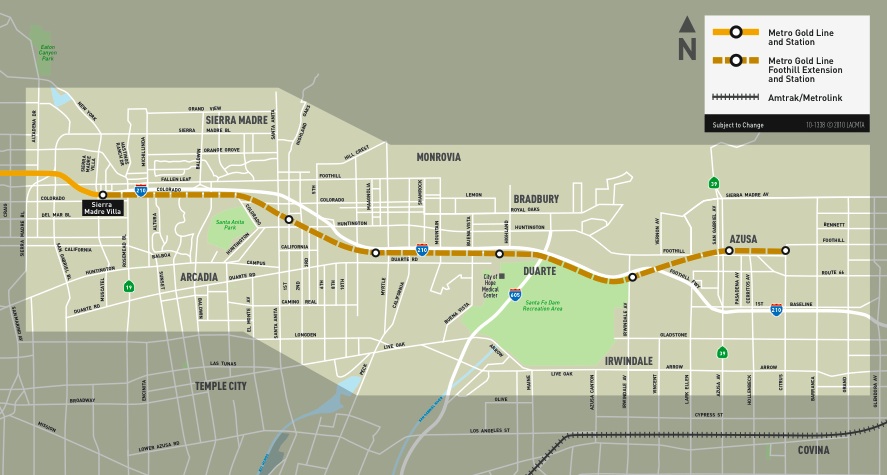 In response to my Los Angeles Times op-ed last week criticizing the Gold Line Foothill extension for not being a cost-effective use of taxpayer dollars, Los Angeles County Metro Vice Chairman and Duarte Councilman John Fasana and San Gabriel Valley Council of Governments President and Glendora Mayor Pro Tem Gene Murabito wrote a letter to the Times in rebuttal.
In response to my Los Angeles Times op-ed last week criticizing the Gold Line Foothill extension for not being a cost-effective use of taxpayer dollars, Los Angeles County Metro Vice Chairman and Duarte Councilman John Fasana and San Gabriel Valley Council of Governments President and Glendora Mayor Pro Tem Gene Murabito wrote a letter to the Times in rebuttal.
Their arguments boil down to three points:
- The San Gabriel Valley extension was cheap to build. True, but that doesn’t change the cost-effectiveness equation. It’s about ridership, too, and this line and its further extension to Montclair score weakly in that regard (for example, see page 47 of this draft report PDF ranking rail transit projects for Metro back in 2006).
- Projected ridership on the route is expected* to be great! *15 years from now. Yes, they say that by 2030 ridership should be comparable to other lines. I guess I’ll have to check in with them in a few decades to confirm. But in the meantime, the line is projected to carry just a fraction of the riders on the rest of the Gold Line, at 13,600 daily trips (compared to 40,000 for the rest of the line).
- Smart growth will happen along the route, boosting ridership to sufficient levels. Here is where Fasana and Murabito are actually able to address my concerns. More dense development around the stations, particularly with offices and affordable housing, could help salvage the investment.
But as Yonah Freemark pointed out back in 2010, many of the stations are in the middle of the freeway or otherwise not very pedestrian accessible, making transit-oriented development hard. And the developments that are being discussed appear to be of the parking-rich low-rise stuff — not what would be needed to boost ridership significantly.
In general, I think it could make sense to build cheap rail transit to areas where development will be built (“skating to where the puck is going”). So I’m not opposed to the principle that Fasana and Murabito espouse to justify this investment. But regional transit leaders should have gotten better assurance that sufficient transit-oriented development will and could be built before they coughed up the money.
Finally, I can’t help but note Fasana and Murabito’s charge in the opening of their letter that I “turn[ed] a blind eye to many facts due to his parochial view of the county’s transportation problems.” If advocating for rail transit in densely populated parts of Los Angeles County makes me parochial, then guilty as charged.
But I have to admit, it’s pretty rich to be accused of parochialism from a part of the county that threatened to torpedo the entire Measure R county sales tax proposal back in 2008 if they didn’t get this local project funded. Not to mention that they’re from a part of the county where people complain when more population-rich areas get rail transit funds first, as if people in the San Gabriel Valley don’t work in these job centers or benefit from the economic growth concentrated there. If ever there was a region of the county that cornered the market on parochialism, it would have to be the San Gabriel Valley.
Otherwise, I certainly don’t begrudge Fasana and Murabito for sticking up for their project. And they may be right that the ridership numbers will pan out. But if they really want to change my mind, they need to get to work ensuring that dense development actually is planned and built in the station neighborhoods.
And in the meantime, regional leaders should work to make sure that over-sized investments like the Foothill extension don’t happen again, at least not without better assurance that ridership projections will actually materialize.


